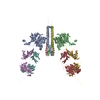+Search query
-Structure paper
| Title | A potent Henipavirus cross-neutralizing antibody reveals a dynamic fusion-triggering pattern of the G-tetramer. |
|---|---|
| Journal, issue, pages | Nat Commun, Vol. 15, Issue 1, Page 4330, Year 2024 |
| Publish date | May 21, 2024 |
 Authors Authors | Pengfei Fan / Mengmeng Sun / Xinghai Zhang / Huajun Zhang / Yujiao Liu / Yanfeng Yao / Ming Li / Ting Fang / Bingjie Sun / Zhengshan Chen / Xiangyang Chi / Li Chen / Cheng Peng / Zhen Chen / Guanying Zhang / Yi Ren / Zixuan Liu / Yaohui Li / Jianmin Li / Entao Li / Wuxiang Guan / Shanshan Li / Rui Gong / Kaiming Zhang / Changming Yu / Sandra Chiu /  |
| PubMed Abstract | The Hendra and Nipah viruses (HNVs) are highly pathogenic pathogens without approved interventions for human use. In addition, the interaction pattern between the attachment (G) and fusion (F) ...The Hendra and Nipah viruses (HNVs) are highly pathogenic pathogens without approved interventions for human use. In addition, the interaction pattern between the attachment (G) and fusion (F) glycoproteins required for virus entry remains unclear. Here, we isolate a panel of Macaca-derived G-specific antibodies that cross-neutralize HNVs via multiple mechanisms. The most potent antibody, 1E5, confers adequate protection against the Nipah virus challenge in female hamsters. Crystallography demonstrates that 1E5 has a highly similar binding pattern to the receptor. In cryo-electron microscopy studies, the tendency of 1E5 to bind to the upper or lower heads results in two distinct quaternary structures of G. Furthermore, we identify the extended outer loop β1S2-β1S3 of G and two pockets on the apical region of fusion (F) glycoprotein as the essential sites for G-F interactions. This work highlights promising drug candidates against HNVs and contributes deeper insights into the viruses. |
 External links External links |  Nat Commun / Nat Commun /  PubMed:38773072 / PubMed:38773072 /  PubMed Central PubMed Central |
| Methods | EM (single particle) / X-ray diffraction |
| Resolution | 2.94 - 3.24 Å |
| Structure data | EMDB-36760, PDB-8k0c: EMDB-36761, PDB-8k0d:  PDB-8xc4: |
| Chemicals |  ChemComp-NAG: |
| Source |
|
 Keywords Keywords | VIRAL PROTEIN / Henipavirus / Attachment glycoprotein tetramer complex / neutralizing antibody / dynamic structures / ANTIVIRAL PROTEIN/IMMUNE SYSTEM / Glycoprotein / Head domain / Antibody / ANTIVIRAL PROTEIN / ANTIVIRAL PROTEIN-IMMUNE SYSTEM complex |
 Movie
Movie Controller
Controller Structure viewers
Structure viewers About Yorodumi Papers
About Yorodumi Papers







 nipah virus
nipah virus
